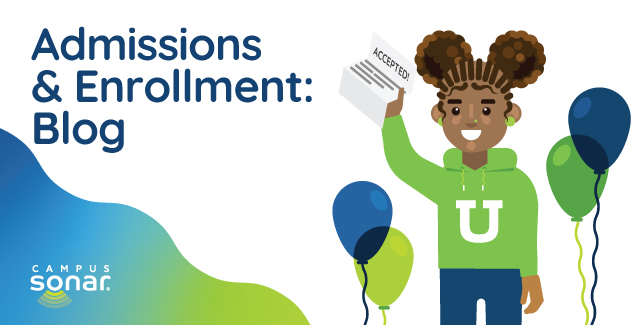Admissions conversation focused on navigating transitions with the prevalent theme of why—or why not—they're attending college.
by Katlin Swisher, Campus Sonar Senior Strategist

In our Admissions: Audience Excitements and Pain Points report, which examined conversations from prospective and admitted college students during the September 1, 2021–May 1, 2022 recruitment cycle, we observed a wide range of student college-going motivations and reflections. Students discussed navigating transitions—from high school to college, departing college and returning, transferring to other campuses, or pursuing college for the first time as nontraditional students. These varying journeys demonstrate that college continues to be a pivotal, emotional, and life-changing experience.
The most prevalent theme across this conversation describes the desire to attend college—or not—and why. A consistent conversation topic within this theme was students’ motivations for enrolling in college and how they assess the value of a college degree, including the determining factors in their college-going decisions. These factors include both whether to enroll in college at all as well as how they’re narrowing down their best-fit campuses.
Under Pressure
College preparation is among the most stressful times students have experienced in their lives to date. Whether they’re avidly exploring, researching, and narrowing their college-going options or determining what their postsecondary future looks like and if college is part of that plan, the pressure is on, and your students felt it throughout the 2021–2022 academic year.
Many students expressed broad pressure about making a decision as to whether or not to go to college. This indecisive, overwhelming feeling was often brought on by comments and questions from family, counselors, and teachers. Some contemplated feeling stuck between the polarizing options of going to college or continuing to live at home without optimal job prospects. Others described feeling intimidated, both about being smart enough or qualified to attend college and whether they had what it takes to succeed as well as by navigating unfamiliar, complicated admissions processes.
Forum threads often detailed different options for after high school, with students seeking advice as to the best path forward for their future for happiness or financial security. Students also used forums to discuss the pressure of choosing between a few campuses where they’d already been admitted, weighing the pros and cons of each option. The pressure continued to amp up as the May 1 decision day loomed.
Questions to Consider
- The admissions process continues to feel ambiguous, stressful, and confusing to many prospective students. How can your campus help them navigate it with empathy, compassion, and clarity?
- What systems do you have in place to listen to conversations on forums to learn factors in students’ college-going decisions and what obstacles they face in making them?
Major Implications
Another layer to this pressure was uncertainty about what to study and how that affected students’ college-going decisions. Some students commented that their academic and career uncertainty made the prospect of enrolling in college feel pointless or a waste of time.
While some students made initial decisions about their major, they also described being constrained by the limitations within degree programs, desiring to just learn. Just like with narrowing down the decision about where to enroll, students often used forums and social media to seek advice about what to study to narrow down their decisions.
Questions to Consider
- How can you incorporate more personalized major guidance and academic advising in your recruitment strategy?
- How can you connect with students earlier to support their academic and career exploration?
Money Counts
Cost continues to play a critical role in the decision to enroll (and if so, where). Students express concerns about the rising cost of college, worrying about their financial futures with student loans and whether college is a worthwhile investment.
Many students are concerned that college costs may land them in debt they’ll never pay off and prevent them from reaching a financial capacity that allows them to reach home ownership, hindering their quality of life in the future. More specifically, some students shared fears that the expected salaries for their dream careers aren’t compatible with the debt they’d accumulate pursuing careers in those fields, placing them in predicaments about how to proceed.
Some students describe college as their only pathway to financial independence and outline clear goals with specific career paths to get them there. Other students discussed their journeys of enrolling in college and subsequently stopping or dropping out for various reasons. Many aspire to return to campus, but worry about the financial implications especially if they’re still uncertain about their preferred major or career path. This theme presents a clear need for customized support and flexibility in the areas of retention, transferring, re-enrolling, and online learning.
Questions to Consider
- With ongoing concerns about increasing costs of college and accumulating debt, how is your campus communicating financial aid-related information?
- How can your campus ease the complexity of understanding financial aid processes? What opportunities exist to expand visibility and awareness around financial aid and value to support enrollment goals?
- Take time to collaborate with your academic affairs team to assess your retention strategy and reflect on the language used, including how your campus is communicating about withdrawals, probations, suspensions, reenrollment, and other related academic scenarios. How can you more transparently and empathetically communicate with students about their individual situations?
Forging New Paths
Some students continue to break the mold of the traditional post-high school college journey and time frame, opting to take a gap year or two to ponder their plans further. These decisions are often due to fear of making a bad decision, uncertainty about financial options and feasibility, or more demands on their time from responsibilities at home like caregiving as side effects from the pandemic loom.
Given the uncertainties present in the conversation about best fit academic programs and pathways, the need for more customizable academic options and career counseling is more critical than ever. Beyond that, high schools (whose employees continue to be overburdened as it is) need more capacity for learning about and sharing those pathways with students. There continues to be a disconnect in knowledge about available options and opportunities and connecting with students about them early on in their exploration.
Questions to Consider
- What are your academic brand differentiators? How can you help students learn about them sooner?
- What strategies are in place to exemplify what’s possible with the academic offerings at your campus?
- What updates are needed to your career services to connect more directly and personally with students?
Dreaming Big
Students are excited to go to college for their next big challenge or the next chapter of their lives. Many students shared hopes that college brings them new opportunities not offered in high school, allows them to move past academic disciplines they don’t prefer, and seek positive experiences beyond their current comfort zones.
Some students hope to expand their social lives and have felt constrained by their current environments. In some cases, they’re actively looking to leave their hometowns and totally disconnect with past relationships, so they avoid campuses other students from their high school attend. Others see college as an opportunity to escape their current circumstances, restart, or get their lives on track.
Questions to Consider
- How can you leverage social listening to understand your students’ circumstances leading up to their arrival on campus?
- How can you encourage and support this dreaming through more 1:1 engagement and interactions with your admissions audiences?
Maintaining Existing and Making New Connections
Relationships matter to this generation of incoming students. A key factor in their decision to enroll (if at all) and where are the people in their lives. Many students reflected on their impending graduations and the rapid changes taking place. Some expressed fears of losing touch with friends and family and leaving them behind. Others reflected on the loneliness they anticipated as they prepared to move to a new place.
These emotions have always been felt during major life transitions like moving away from home for the first time and anticipating a new educational environment. However, following the separation and isolation experienced during the COVID-19 pandemic, it’s clear that relationships matter to students more than ever and they seek more interpersonal connections and support as they determine whether to go to college and anticipate those changes.
Questions to Consider
- Identifying and understanding these real-time feelings are so valuable for your student life team. How can you partner with them early in the recruitment cycle to establish a welcoming, connectional environment on campus?
- How can your campus connect with students 1:1 to begin building those relationships sooner than orientation or welcome week?
- How can you empathize with what your students are experiencing through your admissions messages?
Mental Health Matters
These lasting pressures weigh on students’ mental health, and conversely, students’ mental health is a factor in their college-going choices. Students who live with anxiety, depression, and ADHD in particular worry about the college experience. Several students point to these challenges as making college difficult or a place they’re scared to go to start with.
These conversations reflect that students aren’t confident that colleges will be supportive of them and their mental health challenges—a gap in higher ed’s mission to support and empower student success.
Questions to Consider
- How is your campus creating a culture of care to support students’ mental health concerns? What adjustments are needed in the admissions process to support students as they are applying and once they arrive on campus?
- What additional resources are needed on your campus? Consider ways to provide reassurance and support while highlighting tangible examples of care in your messaging.
Conclusion
The value of college and the right time to enroll—if at all—continues to weigh heavily on students’ minds. Campuses who prioritize understanding students’ changing circumstances, spotlighting how they can help long term, will make a lasting impression with this audience. The need and capacity to engage students does not end once they’re admitted—it continues throughout their time on campus.
